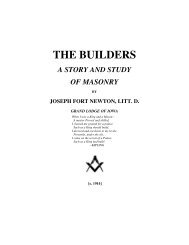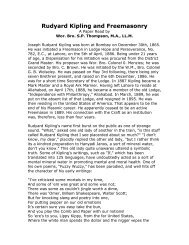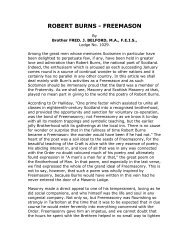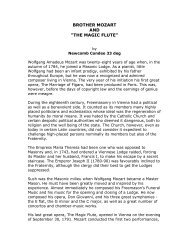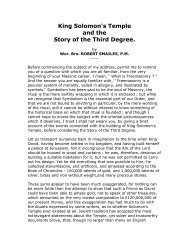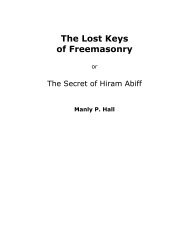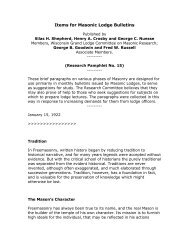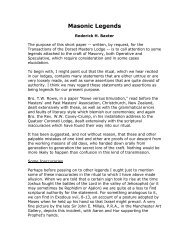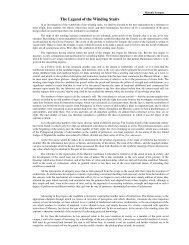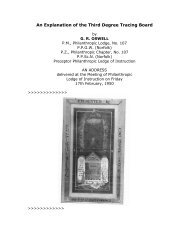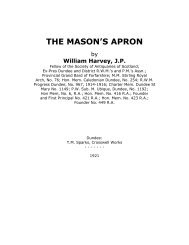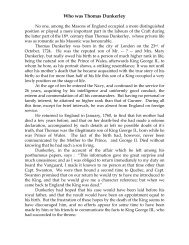Through the Key Hole - RoseCroix.org.au
Through the Key Hole - RoseCroix.org.au
Through the Key Hole - RoseCroix.org.au
You also want an ePaper? Increase the reach of your titles
YUMPU automatically turns print PDFs into web optimized ePapers that Google loves.
119<br />
of <strong>the</strong> Sun, and follow his beneficent course.” Blue Masonry has retained<br />
<strong>the</strong> circuits but has utterly lost <strong>the</strong> explanation; which is that in<br />
<strong>the</strong> Mysteries <strong>the</strong> candidate invariably represented <strong>the</strong> Sun, descending<br />
Southward toward <strong>the</strong> reign of <strong>the</strong> Evil Principle, Ahriman<br />
Siba or Typhon ( darkness and winter); <strong>the</strong>re figuratively to be slain,<br />
and after a few days to rise again from <strong>the</strong> dead, and commence to<br />
ascend northward.<br />
Steinmetz, Freemasonry Its Hidden Meaning.<br />
The Rite of Circumambulation is most ancient. It is <strong>the</strong> Rite of Purification<br />
of him who is about to be initiated. The direction taken is to<br />
comply with <strong>the</strong> ancient saying “If you would do reverence to <strong>the</strong><br />
gods, you must turn on <strong>the</strong> right hand”. Moronically, <strong>the</strong>re is additional<br />
significance: <strong>the</strong> ‘right is <strong>the</strong> stronger side of mind’; it symbolises<br />
<strong>the</strong> psychical side of his nature, also Universal Law—Jachin”<br />
Thus in reverencing <strong>the</strong> gods, <strong>the</strong> right hand and <strong>the</strong> right side are<br />
kept toward <strong>the</strong> altar.<br />
This custom in turn has its origin in ancient solar worship and exemplifies<br />
“ as <strong>the</strong> Sun in his course moves round <strong>the</strong> world by way of<br />
<strong>the</strong> south, so do I follow that luminary, to obtain <strong>the</strong> benefit arising<br />
from a journey round <strong>the</strong> earth by way of <strong>the</strong> south”.<br />
57<br />
IF STONES COULD TALK<br />
From “The Square”<br />
In <strong>the</strong> September 1997 issue of <strong>the</strong> magazine “The Square” published<br />
in Surrey, England. There appeared an araticle entitled<br />
“Bush Tucker Man” in which Major Les Hiddens reported seeing<br />
Aboriginal Australians in Western Australia, giving Masonic signs<br />
when approached. Les Hiddens was not a Freemason, but one of<br />
his party was, and it was on this bro<strong>the</strong>r’s say-so that <strong>the</strong> occurrences<br />
were reported.<br />
The first human beings to be found in Australia, <strong>the</strong> Aborigines,<br />
could in no way have been Freemasons with knowledge of <strong>the</strong><br />
signs of recognition. How <strong>the</strong>n was this possible?<br />
A <strong>the</strong>ory is suggested as follows:<br />
On <strong>the</strong> 4 June 1629, <strong>the</strong> vessel “Batavia” out of Java was wrecked<br />
on Abrolhos Island off <strong>the</strong> Western coastline of Australia. The<br />
Commander Francois Pelsaert and 315 o<strong>the</strong>rs survived <strong>the</strong> wreck.<br />
Fifty chose to return to Java in an open boat to fetch help. Mutineers<br />
murdered 125 whilst o<strong>the</strong>r survivors fled inland to mix with<br />
<strong>the</strong> Aboriginals. It is suggested that amongst this group <strong>the</strong>re must<br />
have been a few Freemasons, based on what was subsequently<br />
found in <strong>the</strong> wreck of <strong>the</strong> “Batavia”, 3 1/2 centuries later.<br />
What was left of <strong>the</strong> ship was salvaged from <strong>the</strong> sea and is now<br />
preserved in <strong>the</strong> Fremantle Maritime Museum in Western Australia.<br />
The amazing thing, however, was that <strong>the</strong> stone ballast found in<br />
<strong>the</strong> ship was in <strong>the</strong> form of prepared stonework which was reassembled<br />
in <strong>the</strong> museum. From <strong>the</strong> picture shown overleaf it is<br />
clear that this archway has a distinct Masonic appearance with a<br />
column and plinth construction and an arch and keystone.<br />
The marks made by <strong>the</strong> iron tools used by <strong>the</strong> operative masons of<br />
<strong>the</strong> day are still easily discernable. From whence <strong>the</strong> stonework<br />
came, and its intended purpose, is not known, but it is proposed<br />
that bec<strong>au</strong>se of this finding, <strong>the</strong> possibility of Freemasons being on



